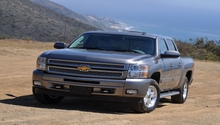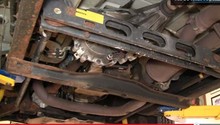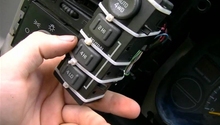Chevrolet Silverado 1999-2006: 4WD Transfer Case Overview
If you're using your Silverado for towing, hauling, or off-roading, knowledge about transfer cases and 4WD systems is important to have. So find out more about your transfer case with this helpful article.
This article applies to the Chevy Silverado GMT800 (1999-2006).
The transfer case is located to the rear of the transmission and contains two yokes. The rear yoke connects to the rear drive shaft, which is always engaged because it controls the rear axle in 2WD. When you switch the truck into 4WD, the transfer case control module forces the transfer case to engage the front wheel drive shaft, which locks the front CV axle.
Off-road aficionados owe a lot of gratitude to the inventor of the transfer case. Without that giant hunk of metal under the truck, there would be a lot more people getting stuck in the mud, sand, or hills. But how exactly does a transfer case work, and why is it so important? Continue reading for the answers.
The Basics
No matter what kind of transfer case you have in your truck, they all generally function the same way. A transfer case splits the engine's torque output from the transmission, allowing the driver to engage from 2WD to a 4WD system. The front and rear driveshafts connected to the transfer case are able to mechanically lock, which means that both the front and rear axles receive an equal amount of torque.

Most modern transfer cases are chain-driven to deliver torque, while older vehicles used a set of gears. Chains are lighter as well as quieter than gears, but gears can often withstand greater amounts of torque and they don't stretch like chains do. Likewise, older cast iron transfer case housings are much heavier than modern aluminum or magnesium housings, but the cast iron material is also less prone to cracking under severe stress.
Two-Speed Transfer Cases
Much like a transmission, transfer cases often feature more than one gear. Most are two speed units, which are split into a high and low range. Engaging the low range gear multiplies the torque moving to the driven wheels, giving you more effective pulling and climbing power at low speeds. Older, single range units split power between the front and back without any sort of mechanical link. It also works fine in low traction conditions, but not well under extreme conditions.

Part-Time vs Full-Time Transfer Cases
Part-time transfer cases can be manually shifted between 2WD and 4WD, while full-time cases are always in 4WD mode. Part-time cases generally allow for better fuel economy and less wear on 4WD components, since locking the front and rear axles can be engaged only when needed. Some modern vehicles feature hybrid full/part-time cases, which feature computer-controlled operation.

Related Discussions
- Transfer Case Problems - ChevroletForum.com
- Transfer Case Trouble - ChevroletForum.com
- Transfer Case Flush Question - ChevroletForum.com






